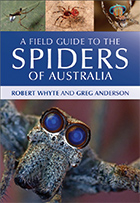This small ant-eating ant-mimic is mostly found in or near a rolled leaf retreat in lush habitats in South East Queensland, including gardens. Its range probably extends further. The female can grow to 4mm, the male to around 3.5mm. The front legs seem to mimic an ant's antennae. The body is dark brown to black in colour, usually brownish in the head region and darker to black at the rear of the abdomen which has two humps with a waist-like constriction, imitating the body segments of an ant. At the waist there are two large white spots. Both the female and the male have white crescents behind the posterior lateral eyes, white tufts at the edges of the fovea and a large brush of stiff black setae (hairs) on the underneath of englarged tibiae. This specimen resembles Rhombonotus L. Koch, 1879 but not exactly. In Zabka's view all described and undescribed Rhombonotus spp. should be considered Ligonipes (Zabka 2012, pers. comm.).
- Female adult, from above 19-03-09
- Female epigyne with alcohol 19-03-09
- Female facing showing tufts and metatarsal spines
- Female from side waving front legs
- Made adult from above facing
- Male adult from above behind
- Male adult brush of hairs on tibia
- Male adult from side facing
- Female
- Ligonipes whitebrows 17-10-10 epigyne
- Female adult
- Female adult 28-05-10
Female adult, from above 19-03-09

Female epigyne with alcohol 19-03-09

Female facing showing tufts and metatarsal spines

Female from side waving front legs

Made adult from above facing

Male adult from above behind

Male adult brush of hairs on tibia

Male adult from side facing

Female
Ligonipes whitebrows 17-10-10 (aka Rhombonotus) same as 238GJA short spines on tarsus, PMEs somewhat closer to ALEs than PLEs but not so dramatically as in Rhombonotus gracilis sensu Koch.

Ligonipes whitebrows 17-10-10 epigyne

Female adult

Female adult 28-05-10


